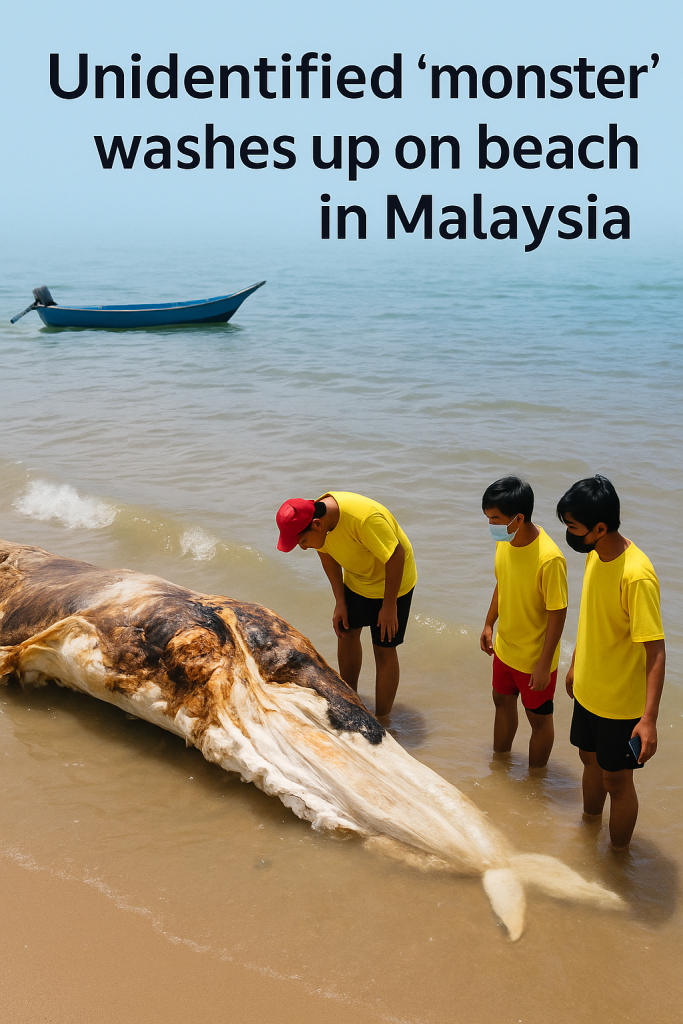In an extraordinary and puzzling marine event, an unidentified creature—dubbed a “monster” by local residents—was found washed up on a beach in Malaysia earlier this month, sparking widespread intrigue and speculation across social media platforms.
The strange carcass was discovered in early March 2024 on a secluded stretch of coastline in the northern state of Penang, a popular tourist destination known for its palm-lined beaches and rich biodiversity. Visitors and locals alike were stunned by the sight of the large, unrecognizable body lying partially buried in the sand, exhibiting features unlike any known marine animal native to the region.
Visual Description and Initial Reactions
The mysterious creature, measuring approximately 3 meters in length, appeared to have a misshapen, elongated body with rough, leathery skin and a large gaping mouth that added to its nightmarish appearance. Several witnesses reported unusual appendages that resembled tentacles or elongated flippers, contributing to the “monster” nickname that quickly spread online.
Beachgoers shared photos and videos that went viral within hours, prompting an outpouring of theories ranging from “deep-sea cryptid” and alien lifeform speculations to more grounded guesses centering on decomposed whale or giant squid remains. Yet, due to the level of decomposition and distortion from tidal action, experts initially faced difficulty identifying the organism.
Scientific Investigation Underway
Marine biologists and environmental authorities in Malaysia were swiftly alerted and visited the site to collect samples and document the specimen. Early examination suggests that the carcass could belong to a deep-ocean creature rarely seen near coastal waters, possibly a deep-sea cephalopod or an unusual type of fish that was disoriented or sick before washing ashore.
Dr. Nur Aisyah Ramli, a marine biologist familiar with the region’s marine fauna, cautioned that “sea creatures can look drastically different when decomposed or after exposure to saltwater and the sun, which often causes bloating, skin sloughing, and distortion of natural features.” She added that the mystery “creature” could also be a cryptic juvenile of a more common species.
Historical and Cultural Impact
Malaysia, like many maritime countries, has deep-rooted folklore involving sea monsters and mythical creatures, and the sighting has reignited local interest in these age-old stories. For some coastal communities, such events evoke concern and superstition, while for others, they spark fascination and scientific curiosity.
“It’s both eerie and exciting,” said a local fisherman. “You wonder what else is lurking in the deep, unseen by human eyes.”
Environmental and Scientific Significance
Experts have highlighted that such beachings, while rare, provide valuable opportunities for studying ocean biodiversity and understanding the health of marine ecosystems, especially amid increasing environmental pressures like climate change, pollution, and overfishing. Identifying the creature could shed light on changes happening in deep-sea habitats or unrecorded animal migrations.
Authorities have since removed the carcass for further analysis in a laboratory, where advanced techniques such as DNA sequencing and radiographic imaging will be used to ascertain its identity conclusively.
What’s Next?
While answers are pending, the mysterious “monster” of Penang continues to capture public imagination, sparking conversations about the ocean’s unexplored mysteries and the importance of marine conservation. Officials urge the public to stay clear of the site and report



